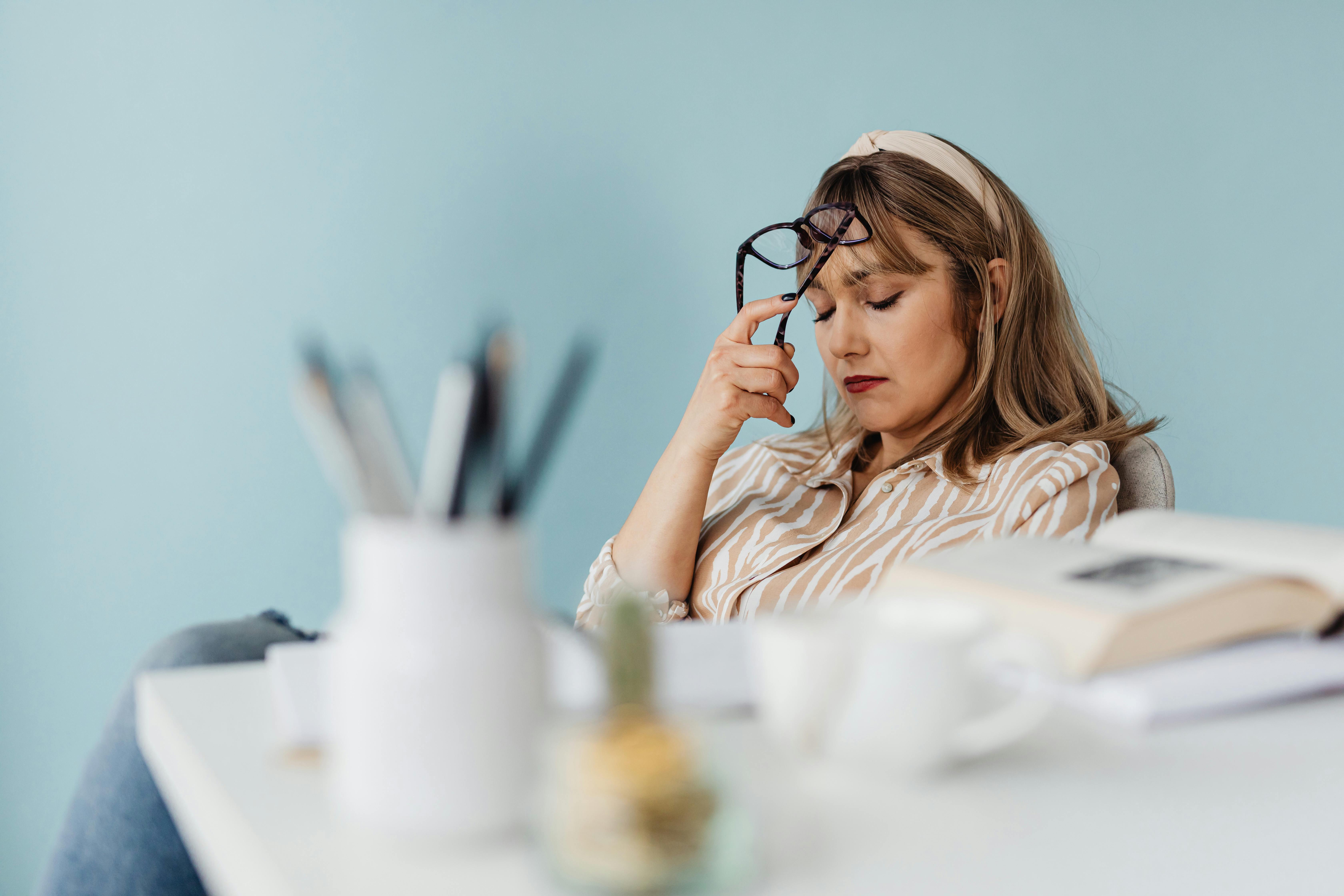
20-Minute Eye Break Routine to Refresh Tired Eyes
If your eyes feel heavy, dry, itchy, or tense after hours of scrolling through social media, working on spreadsheets, or gaming into the night, you’re far from alone. In today’s hyper-connected world, the average adult spends over 7 hours a day in front of a digital screen—and for many, it’s much more. That’s nearly a third of your day with your gaze locked on a glowing rectangle.
This prolonged, close-up focus forces the tiny muscles in your eyes to work overtime, often leading to digital eye strain—a cluster of symptoms that can include blurred vision, headaches, watery eyes, light sensitivity, and even neck and shoulder pain from the way we unconsciously lean toward our devices.
But here’s the best part: relief is closer than you think. You can “reset” your eyes and give them a much-needed break in just 20 minutes. This isn’t some complicated medical regimen—it’s a simple, science-backed routine that helps relax your eye muscles, replenish moisture, and restore mental clarity. Think of it as a mini spa session for your vision, one that not only protects your eyesight for the long run but also boosts your comfort and focus for the rest of the day.
Why Your Eyes Need a Reset After Long Screen Sessions
The impact of digital eye strain
When you spend long stretches staring at a screen, something surprising happens—your blink rate drops by nearly 60%. Instead of blinking a healthy 15–20 times per minute, you might blink only 7–10 times. Those missing blinks mean your eyes aren’t spreading enough natural tears across the surface, causing them to dry out faster.
At the same time, your eye’s focusing muscles—tiny but hardworking—stay in a constant state of contraction as they lock onto close-up text and images. It’s like holding a dumbbell without putting it down; eventually, those muscles grow tired and sore. This strain can trigger tightness around your temples and brows, making it harder to concentrate.
And here’s the worrying part: if left unchecked, unmanaged screen fatigue doesn’t just make you uncomfortable—it may even contribute to the progression of near-sightedness (myopia), especially in children and young adults whose eyes are still developing.
Signs You’re Overdue for an Eye Break (and Why They Happen)
1. Dry, Itchy, or Watery Eyes
When you focus on a screen, you blink less often, which means your eyes aren’t getting enough moisture. In response, your tear glands may produce more watery tears, but these don’t properly lubricate your eyes, leaving them feeling irritated.
How the 20-minute routine helps: The blinking exercises and hydration steps in the routine help restore a healthy tear film, reducing dryness and itchiness almost immediately.
2. Difficulty Focusing at a Distance
Your eyes’ focusing muscles (ciliary muscles) work overtime when you stare at something close for hours. Switching to a distant object suddenly can feel like trying to stand up after sitting cross-legged for too long—you need a moment to adjust.
How the 20-minute routine helps: The 20-20-20 rule and focus-shifting exercises gently stretch and relax these muscles, helping your eyes transition between near and far vision more easily.
3. Increased Sensitivity to Light
Staring at bright screens, especially in dim environments, can cause your pupils to stay constricted for long periods. This makes sudden changes in light levels more uncomfortable.
How the 20-minute routine helps: Palming relaxation and light adjustments in the routine give your eyes a chance to rest in darkness, reducing light sensitivity and improving comfort.
4. Headaches Behind the Eyes
Eye strain forces the muscles around your eyes to stay tense for long stretches, which can lead to dull, throbbing headaches centered behind the eyes or across the forehead.
How the 20-minute routine helps: Gentle eye stretches and posture resets help release this tension, improving circulation and reducing pressure in and around the eye sockets.
5. Neck or Shoulder Stiffness
When your eyes get tired, your posture often shifts—you may unconsciously lean forward or crane your neck toward the screen, creating strain in your neck, shoulders, and upper back.
How the 20-minute routine helps: The posture and workspace reset portion of the routine encourages you to move, stretch, and realign your body, breaking the cycle of muscular tension.
If several of these sound familiar, it’s your body’s way of saying: Step back. Blink. Breathe. Give me a break.
The 20-Minute Eye Break Routine
You don’t need fancy gadgets—just a timer, a comfortable seat, and a bit of commitment.
Step 1: 20-20-20 rule reset (2 minutes)
Every 20 minutes, look at something 20 feet away for 20 seconds. This relaxes the ciliary muscles in your eyes, reducing strain. During this 2-minute block, repeat the process several times while focusing on different objects at varying distances.
Step 2: Blink and hydrate (3 minutes)
When working at a screen, we often blink only 7–10 times per minute instead of the normal 15–20. Consciously blink slowly and fully to refresh your tear film. Pair this with drinking a glass of water—hydration helps maintain healthy tear production.
Step 3: Palming relaxation (4 minutes)
Rub your palms together to create gentle warmth. Close your eyes and cup your palms over them without applying pressure. Let your eyes rest in complete darkness while focusing on slow, deep breathing. This encourages full relaxation of the optic nerve and surrounding muscles.
Step 4: Eye stretches and focus shifts (6 minutes)
-
Look up and down slowly, 10 times each.
-
Move your eyes left to right, 10 times each.
-
Roll your eyes in a circular motion clockwise, then counterclockwise.
-
Hold your thumb 10 inches away, focus on it for 5 seconds, then shift to something far away for 5 seconds—repeat 10 times.
These stretches help improve blood flow and reduce muscle tension.
Step 5: Light and posture reset (5 minutes)
Stand, roll your shoulders, and stretch your neck. Adjust lighting to reduce glare—either by dimming overhead lights or using blinds to filter sunlight. Ensure your screen is at eye level and about 20–28 inches away.
Daily Habits to Reduce Screen-Related Eye Fatigue
1. Adjust Screen Brightness and Contrast
Your eyes work hardest when there’s a big mismatch between screen brightness and the surrounding light. An overly bright display in a dim room can cause glare, while a dim screen in bright light forces your eyes to strain for clarity.
Aim to match your screen’s brightness to the lighting in your environment. If you’re working in daylight, slightly increase brightness; if you’re in a softly lit room, reduce it. Adjust contrast so text and images appear sharp without being harsh. Consider using your device’s auto-brightness feature to adapt to changing conditions throughout the day.
2. Position Your Workspace for Comfort
Poor monitor placement doesn’t just affect your eyes—it can throw off your entire posture. A screen that’s too low can cause you to hunch forward, while one that’s too high can strain your neck and shoulders.
Place your monitor so the top third of the screen is at or just below eye level. You should be able to look at your work without tilting your head up or down. Keep the screen about 20–28 inches (roughly arm’s length) from your eyes. If you use a laptop, consider a stand and external keyboard to achieve proper alignment.
3. Stay Hydrated for Eye Health
Your eyes rely on a stable tear film to stay comfortable and protected. Even mild dehydration can reduce tear production, leading to dryness, irritation, and more frequent blinking discomfort.
Keep a water bottle within reach and sip regularly throughout the day—not just when you feel thirsty. Herbal teas and water-rich foods like cucumber, watermelon, and oranges can also help. Remember: caffeine and alcohol can dehydrate you, so balance them with extra water.
Frequently Asked Questions
1. How often should I take an eye break if I work on a computer all day?
Ideally, you should follow the 20-20-20 rule every 20 minutes—looking at something 20 feet away for 20 seconds. But beyond that, aim to do the full 20-minute eye break routine at least once every 2–3 hours of continuous screen time. If your job involves intense focus (like coding, graphic design, or writing), you might benefit from a second or even third routine throughout the day. Regular breaks help relax your eye muscles, replenish moisture, and reduce the risk of developing or worsening digital eye strain symptoms.
2. Will doing eye exercises actually improve my vision?
Eye exercises won’t magically reverse refractive errors like nearsightedness or farsightedness—that requires corrective lenses or medical treatment. However, they can improve your visual comfort, focusing speed, and endurance during screen use. By regularly shifting focus, stretching eye muscles, and blinking more often, you can prevent fatigue, maintain sharper focus, and reduce headaches associated with prolonged computer work. In short, they help your eyes work better for longer without discomfort.
3. Is blue light the main cause of my screen-related eye strain?
Not necessarily. Blue light gets a lot of attention because it can disrupt sleep patterns if you use screens late at night, but the primary cause of digital eye strain is prolonged near-focus without breaks. This keeps your ciliary muscles in a constant state of tension and reduces your blink rate. That said, using blue light filters or “night mode” in the evening can still be beneficial—especially if you have trouble falling asleep after late-night screen use.
4. Can eye strain lead to permanent damage?
Eye strain itself doesn’t typically cause permanent damage to your vision, but it can make existing issues worse or accelerate certain problems in people already at risk. For example, in children and young adults, excessive screen time without breaks may contribute to the progression of myopia (nearsightedness). Additionally, long-term dryness can cause surface irritation and discomfort. Taking regular breaks is an easy, preventative measure to protect your eye health for the future.
5. What if I don’t have 20 minutes for a full routine?
Even if you can’t spare the full 20 minutes, mini breaks can still make a difference. Try doing a condensed version:
- 1–2 minutes of the 20-20-20 rule
- 1 minute of slow, deliberate blinking
- 1–2 minutes of palming or looking into the distance
These micro-breaks will still help relax your eyes, restore moisture, and reduce tension. Think of them as quick “eye snacks” between your full “eye meal” routines.
Final Thoughts
Your eyes are working harder than ever in our screen-saturated world. Every email you answer, every spreadsheet you update, every show you binge adds to the strain. Over time, this constant demand can chip away at your comfort, focus, and even your long-term vision health.
That’s why a 20-minute eye break routine isn’t just a “nice to have”—it’s one of the smartest self-care investments you can make. In the time it takes to drink a cup of coffee, you can relieve tension, rehydrate your eyes, reset your focus, and give your vision the protection it deserves.
The best part? You don’t have to wait weeks to see results. Try it today—set a reminder, follow the steps, and pay attention to how your eyes feel afterward. You might notice you can read text more easily, your headaches are less intense, and your screen feels less like a burden and more like a tool.
Your eyes are your window to the world—take 20 minutes to give them the care they need, every single day.

Professor Eleanor Grace Whitfield
Professor of Ophthalmology • Vision Science Author • Public Health Advocate
Professor Eleanor Grace Whitfield is a leading English ophthalmologist, academic, and author, specializing in corneal disorders, refractive surgery, and global eye health policy.
She is known for her research in early detection of corneal disease and her advocacy for equitable access to vision care worldwide.